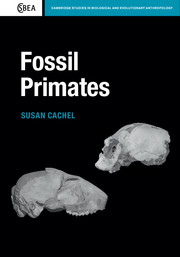Book contents
- Frontmatter
- Dedication
- Contents
- Acknowledgments
- Preface
- 1 Introduction: primates in evolutionary time
- 2 Primate taxonomy
- 3 Fossils and fossilization
- 4 The world of the past
- 5 The lifeways of extinct animals
- 6 Evolutionary processes and the pattern of primate evolution
- 7 Primate origins
- 8 The Paleocene primate radiation
- 9 The Eocene primate radiation
- 10 The Malagasy primate radiation
- 11 The Oligocene bottleneck
- 12 Rise of the anthropoids
- 13 The platyrrhine radiation
- 14 The Miocene hominoid radiation
- 15 The cercopithecoid radiation
- 16 Late Cenozoic climate changes
- 17 Conclusions
- References
- Index
17 - Conclusions
Published online by Cambridge University Press: 05 April 2015
- Frontmatter
- Dedication
- Contents
- Acknowledgments
- Preface
- 1 Introduction: primates in evolutionary time
- 2 Primate taxonomy
- 3 Fossils and fossilization
- 4 The world of the past
- 5 The lifeways of extinct animals
- 6 Evolutionary processes and the pattern of primate evolution
- 7 Primate origins
- 8 The Paleocene primate radiation
- 9 The Eocene primate radiation
- 10 The Malagasy primate radiation
- 11 The Oligocene bottleneck
- 12 Rise of the anthropoids
- 13 The platyrrhine radiation
- 14 The Miocene hominoid radiation
- 15 The cercopithecoid radiation
- 16 Late Cenozoic climate changes
- 17 Conclusions
- References
- Index
Summary
Primate fossils record the history of a group that showed a precipitous rise in diversity and abundance at the beginning of the Cenozoic. Plesiadapoid primates also demonstrated disparity—as many as 12 zoological families are currently recognized. The plesiadapoid primates were an overwhelming presence during the Paleocene because they were occupying a series of open niches for small-bodied generalized herbivores. After the origin and dispersal of true rodents in the Late Paleocene, primates decline, and they never again achieve the abundance and diversity that they had during the Paleocene. After the extinction of the first major primate radiation (the plesiadapoids), the second radiation of euprimates also suffers an extinction event at the end of the Eocene.
The primate order never recovers from these two major extinction events. Its subsequent history has been a history of decline, even though primate groups that fascinate the public (monkeys and apes) had not yet evolved. Given the prominence of non-human primates on lists of endangered species, one could argue that most living primates are doomed to extinction. Both paleontology and historical records illustrate how rapid the decline in primate numbers can be.
Gelada baboons (Theropithecus gelada) exemplify the dire threat of extinction to non-human primates. At many Pleistocene African sites, they constitute half of all the vertebrate fossils discovered. Beginning 1 mya, they suffer a precipitous decline. Geladas now are found only in the mountains of Ethiopia, and they are fast diminishing in numbers even within this last stronghold. During the 1970s, researchers estimated their numbers as being between 100,000 and 200,000 animals; their current numbers in the wild are estimated to be 20,000—a decline of as much as 90 percent in about 40 years (Tucker, 2009)
- Type
- Chapter
- Information
- Fossil Primates , pp. 259 - 263Publisher: Cambridge University PressPrint publication year: 2015



